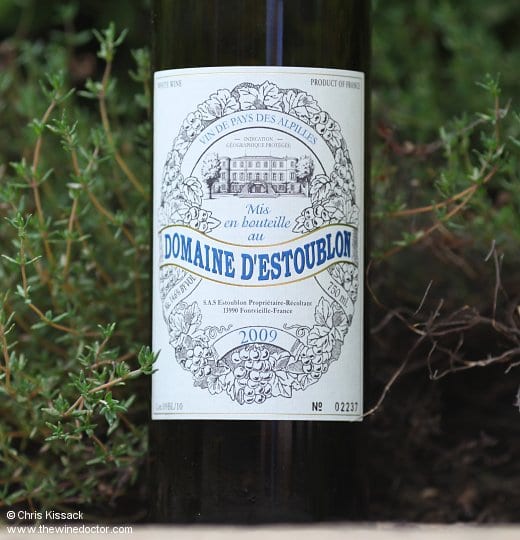Domaine d’Estoublon Blanc 2009
Just a little more than a week ago I attended a really fascinating vertical tasting of Moulin Touchais, the only wine of note to be produced by the Touchais family at their eponymous domaine, Vignobles Touchais, which is located very close to Doué-la-Fontaine, south-west of Saumur, on the edge of the Anjou and Coteaux du Layon appellations. It was a remarkable tasting for many reasons, not least the amazing array of older vintages being poured, and naturally I have published my notes and a profile of Moulin Touchais this week.
What, you might ask, has all this to do with Domaine d’Estoublon, which as Languedoc savants will know is located in Fontvieille, near Arles, and not that far from France’s Mediterranean coast? And thus a long, long way from Anjou and the Loire. Simple. At the tasting I met up with Leon Stolarski, one of the UK’s very strong band of independent merchants who together create much of the buzz when it comes to the UK wine scene, surely one of the richest and most diverse in the world? Leon had a box of samples for me; I lugged them home, carrying them from one delayed East Coast train to the next.
Although a full report on the wines is due soon (I’m afraid I’m only halfway through them – samples tasted at home deserve more than the quick-sip-and-spit wines receive at larger tasting, and so I only open one or two bottles each day) I find I am unable to resist reporting on this wines, from Domaine d’Estoublon, straight away. Such striking wines are discovered only occasionally, and this one was a real delight.

The wine in question is the Domaine d’Estoublon Blanc 2009, a Vin de Pays des Alpilles, which is a region just north of the perhaps more familiar Vin de Pays des Bouches du Rhône region. The domaine is an ancient one, its history stretching back to the Middle Ages. Today it is in the possession of the Schneider family, with Valérie Schneider and husband Rémy Reboul at the helm. Under their guidance the estate now boasts not only a handsome vineyard, but also an olive grove, restaurant and entertainment suite. It might sound as though they lack focus, but that doesn’t seem to be the case. Rémy Reboul began with guidance from Eloi Dürrbach of Domaine de Trevallon, and also engaged the services of the renowned soil specialist Claude Bourguignon. Red and white varieties were planted, exactly those you would expect to see in the region, which for this white wine means Roussanne, Marsanne and Grenache Blanc. The vineyards are organic (Ecocert certification from 2002) and even the organic and biodynamic farmer’s mainstays – copper and sulphur – are excluded from the vineyard. All the treatments are based on plant infusions or essential oils. This commitment continues into the cellar, where the wines are fermented in old wood and 675-litre clay-silica ovoid ‘amphorae’, with aging on the lees.
No sulphur or copper in the vineyard? Fermentation in giant clay amphorae, the size and shape of which is determined by the golden ratio, a mathematical principle embodied within the work of the ancient Greek sculptor Phidias? It all sounds a bit metaphysical, doesn’t it? Which is fine, because the wine is just as striking as the story behind it. In the glass, the 2009 Domaine d’Estoublon Blanc has a fairly dense yellow-gold hue. The nose is fairly fascinating; first up, there is an undeniable oxidative style here, by which I mean oxidative – giving the wine a firm, slightly cheesy-woody-nutty character, but without overt oxidation. In other words, I am using the term ‘oxidative’ (I’m digressing, but I think this point is important) as I believe it should be used, rather than as a term used to ‘dress up’ oxidised wines. This is not oxidised. Alongside there are also some really confidently expressed aromas of orange blossom, apricot, quince and macerated orchard fruits. Following on, the palate has the full and waxy texture of a slightly higher-alcohol wine (declared alcohol 14.6%), but with no spirity heat to betray its presence. And there is a very fine seam of acidity running down the very centre of it, with notes of honeyed fruits, almond paste, dried apricots and menthol-tinged garrigue herbs, all swirled in a polished and lightly waxy texture, and underpinned with a good grip. This is a really interesting wine, challenging and unexpected in terms of style. So much so that I kept returning to it all evening – and the next, as it happens – fascinated by its distinctive character. And isn’t that the effect good wine should have? A wine worthy of a solid recommendation – for those with an open mind. 17.5/20 (17/9/12)
